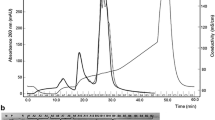Abstract
Recent developments in gene therapy with non-viral vectors and DNA vaccination have increased the demand for large amounts of pharmaceutical-grade plasmid DNA. The high viscosity of process streams is of major concern in the purification of plasmids, since it can cause high back pressures in column operations, thus limiting the throughput. In order to avoid these high back pressures, expanded bed anion exchange chromatography was evaluated as an alternative to fixed bed chromatography. A Streamline 25 column filled with 100 ml of Streamline QXL media, was equilibrated with 0.5 M NaCl in TE (10 mM Tris, 1 mM EDTA, pH=8.0) buffer at an upward flow of 300 cmh-1, E. coli lysates (obtained from up to 3 liters of fermentation broth) were injected in the column. After washing out the unbound material, the media was allowed to sediment and the plasmid was eluted with 1 M NaCl in TE buffer at a downward flow of 120 cmh-1. Purification factors of 36±1 fold, 26±0.4 plasmid purity, and close to 100% yields were obtained when less than one settled column volume of plasmid feed was injected. However, both recovery yield and purity abruptly decreased when larger amounts were processed–values of 35±2 and 5±0.7 were obtained for the recovery yield and purity, respectively, when 250 ml of feedstock were processed. In these cases, gel clogging and expansion collapse were observed. The processing of larger volumes, thus larger plasmid quantities, was only possible by performing an isopropanol precipitation step prior to the chromatographic step. This step led to an enhancement of the purification step.
Similar content being viewed by others
References
Artolozaga MJ, Jonas R, Schneider AL, Furlan SA and Carvalho-Jonas MF (1998) One step partial purification of β-galactosidase from Kluyveromyces marxianus CDB 002 using Streamline DEAE. Bioseparation 7: 137-143.
Barnfield AB, Hjorth R and Hammarström A (1994) Pilot scale recovery of recombinant annexin V from unclarified Escherichia coli homogenate using expanded bed adsorption. Biotechnol. Bioeng. 44: 922-929.
Batt BC, Yabannavar VM and Singh V (1995) Expanded bed adsorption process for protein recovery from whole mammalian cell culture broth. Bioseparation 5: 41-52.
Chang YK and Chase HA (1996a) Development of operating conditions for protein purification using expanded bed techniques: The effect of the degree of expansion on adsorption performance. Biotechnol. Bioeng. 49: 512-526.
Chang YK and Chase HA (1996b) Ion exchange purification of G6PDH from unclarified yeast cell homogenates using expanded bed adsorption. Biotechnol. Bioeng. 49: 204-216.
Chang YK, McCreath GE and Chase HA (1995) Development of an expanded bed technique for an affinity purification of G6PDH from unclarified yeast cell homogenates. Biotechnol. Bioeng. 48: 355-366.
Chase HA (1994) Purification of proteins by adsorption chromatography in expanded beds. Trends Biotechnol. 12: 296-303.
Draeger NM and Chase HA (1991) Liquid fluidized bed adsorption of protein in the presence of cells. Bioseparation 2: 67-80.
Ferreira GNM, Cabral JMS and Prazeres DMF (1997) A comparison of gel filtration chromatographic supports for plasmid purification. Biotechnol. Techn. 11: 417-420.
Ferreira GNM, Cabral JMS and Prazeres DMF (1998) Purification of supercoiled plasmid DNA using chromatographic processes. J. Mol. Recognition 11: 250-251.
Ferreira GNM, Cabral JMS and Prazeres DMF (1999a) Development of process flow sheets for the purification of plasmid vectors for gene therapy applications. Biotechnol. Progr. 15: 725-731.
Ferreira GNM, Cabral JMS and Prazeres DMF (1999b) Monitoring of process streams in the large scale production and purification of plasmid DNA for gene therapy applications. Pharm. Pharmacol. Commun. 5: 57-59.
Ferreira GNM, Cabral JMS and Prazeres DMF (1999c) Studies on the batch adsorption of plasmid DNA onto anion-exchange chromatographic supports. (Submited).
Lahijani R, Hulley G, Soriano g, Horn NA and Marquet M (1996) High-yield production of pBR322-derived plasmids intended for Human gene therapy by employing a temperature controllable point mutation. Hum. Gene Ther. 7: 1971-1980.
Ledley FD (1995) Nonviral gene therapy: The promise of genes as pharmaceutical products. Hum. Gene Ther. 6: 1129-1144.
Lyddiatt A and O'Sullivan DA (1998) Biochemical recovery and purification of gene therapy vectors. Curr. Opin. Biotechnol. 9: 177-185.
Maniatis T, Fritsch EF and Sambrook J (1982) Molecular cloning: laboratory manual. Cold Spring Harbor, New York.
Marcel T and Grausz JD (1997) The TMC Worldwide gene therapy enrollment report, end 1996. Hum. Gene Ther. 8: 775-800.
Marquet M, Horn NA and Meek JA (1995) Process development for the manufacture of plasmid DNA vectors for use in gene therapy. BioPharm. September: 26-37.
Monteiro GA, Ferreira GNM, Cabral JMS and Prazeres DMF (1999) Analysis and use of endonuclease activities in Escherichia coli lysates during the primary isolation of plasmids for gene therapy. Biotechnol. Bioeng. 66: 189-194.
Prazeres DM, Schluep T and Cooney C (1998) Preparative purification of supercoiled plasmid DNA using anion-exchange chromatography. J. Chromatogr. A 806: 31-45.
Prazeres DMF, Ferreira GNM, Monteiro GA, Cooney CL and Cabral JMS (1999) Large-scale production of pharmaceuticalgrade plasmid DNA for gene therapy: problems and bottlenecks. Trends Biotechnol. 17: 169-174.
Robinson HL, Ginsgerg HS, Davis HL, Johnston SA and Liu MA (1997) The scientific future of DNA immunization. American Academy of Microbiology, Washinghton DC, USA.
Sikora K (1996) Scope and limitations of gene therapy. In: Lemoine NRand Cooper DN (ed.) Gene therapy (pp. 1-10). BIOS Scientific Publishers Limited, Oxford, U.K.
USFDA (1996) Addendum to The Points to Consider in Human Somatic Cell and Gene Therapy (draft). US FDA Center for Biologics Evaluation and Research, Rockville, USA.
Author information
Authors and Affiliations
Rights and permissions
About this article
Cite this article
Ferreira, G.N., Cabral, J.M. & Prazeres, D.M. Anion exchange purification of plasmid DNA using expanded bed adsorption. Bioseparation 9, 1–6 (2000). https://doi.org/10.1023/A:1008134822673
Issue Date:
DOI: https://doi.org/10.1023/A:1008134822673




